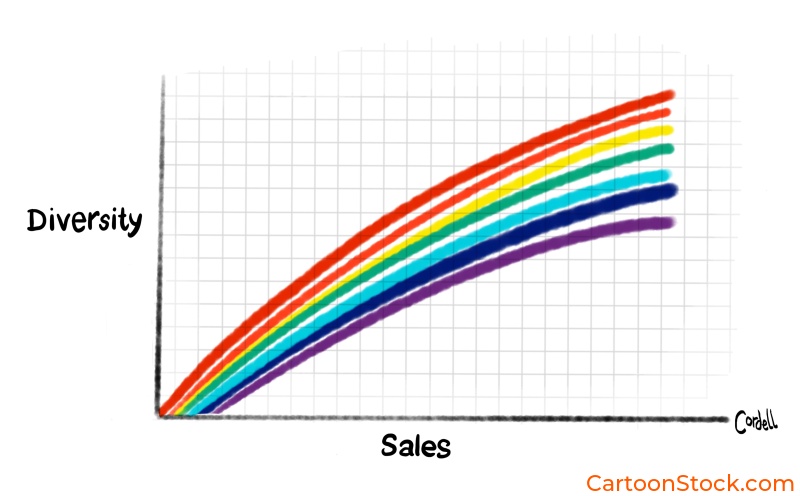When it comes to workplace inclusion, words alone often fall short. Diversity and inclusion (D&I) initiatives are most effective when they engage people not just intellectually, but visually and emotionally too. That’s where cartoons come in. Used well, cartoons can humanize tough conversations, challenge assumptions, and reinforce company values in a way that’s memorable, disarming, and genuinely impactful.
In this article, we’ll explore how businesses can use cartoons for diversity and inclusion in internal communication, training, and beyond.
See our comprehensive guide using cartoons to support diversity, inclusion and belonging for more topics
How Cartoons Visually Reinforce Inclusion Messaging
Take the cartoon featured at the top of this article, for example. It presents a simple business chart with a rainbow-colored arc connecting two axes: Diversity and Sales. It’s clever, it’s colorful, and it makes a clear point in seconds—diversity isn’t just a social good, it’s a strategic one.
This is the kind of visual that doesn’t require explanation. It fits neatly into a presentation slide, an internal campaign, or even an onboarding module, invites reflection while reinforcing a shared value and also works without relying on language, making it accessible across roles, departments, and cultural backgrounds.
Where Businesses Use Cartoons in Their D&I Efforts
Cartoons aren’t just for newsletters. They can—and should—be integrated across a wide range of internal communication touchpoints. Some of the most effective uses include:
- D&I Training Modules: Cartoons help break up heavy topics and make key concepts more memorable.
- Onboarding Programs: Use humor and visuals to show your company’s values in action.
- Internal Campaigns: Whether it’s Diversity Week or a values refresh, cartoons can help drive engagement.
- Intranet and Posters: A well-placed cartoon in the break room or internal portal can spark thought and conversation.
- Meeting Starters: Use a cartoon as a discussion opener during team or leadership meetings.
Wherever you communicate values, culture, or behavior, cartoons for diversity and inclusion can support clarity and connection.
Our team at CartoonStock are experts in knowing which cartoon suits your needs, simply drop us an email using our contact form and somebody will get back to you
Why Humor Helps Create Space for Serious Conversations
Cartoons for diversity and inclusion offer a way into conversations that often involve uncomfortable truths. Bias. Misunderstanding. Exclusion. Cartoons, especially when paired with thoughtful captions, can lower the emotional barrier to entry.
Humor gives people a way in. It invites people to laugh—not at each other, but at shared workplace realities, contradictions, or blind spots. That laughter opens the door to deeper discussion.
Cartoons also give permission to reflect without judgment. When done well, they don’t preach. They prompt.
Tips for Choosing Cartoons for Diversity and Inclusion
Here’s how to ensure your visuals reinforce the message:
1. Avoid Stereotypes
Steer clear of cartoons that reduce people to one-dimensional traits. Look for visuals that reflect nuance, not caricature.
2. Match Tone to Context
A light joke might work in a values campaign but not in harassment training. Choose visuals that support the setting.
3. Use Visual Metaphors
Sometimes the best cartoons don’t show people at all. They use animals, graphs, or surreal scenarios to highlight issues indirectly and safely.
4. Respect Visual Accessibility
Use high-contrast images and add alt-text if posting online. Ensure your team knows how to include everyone.
5. Draw from Trusted Sources
It also shows you’ve invested in quality communication that supports cartoons for diversity and inclusion in a respectful, effective way.
Q&A: Cartoons and Workplace Inclusion
Q: Can cartoons really help advance serious D&I goals?
A: Absolutely. When paired with thoughtful messaging, cartoons support empathy, reflection, and engagement—especially across mixed audiences.
Q: What if employees don’t find the cartoon funny?
A: Not every cartoon needs to be laugh-out-loud funny. Many are simply insightful or clever. The goal is engagement, not comedy.
Q: Is it risky to use humor when talking about identity or inclusion?
A: It can be—if done poorly. But when cartoons are selected thoughtfully and respectfully, they can make sensitive conversations more approachable, not less.
Keep Reading:
Next Article: Using Cartoons to Simplify Complex Workplace Policies & Instructions


